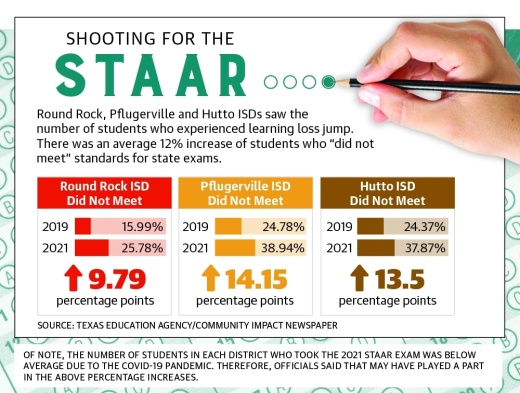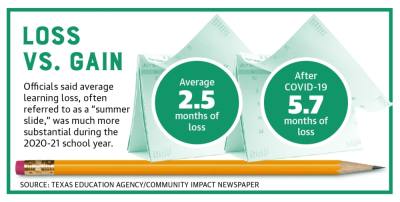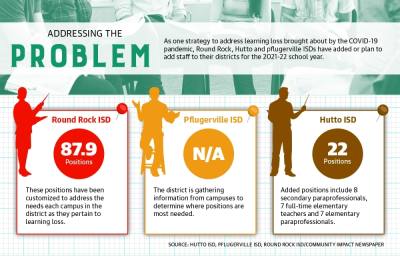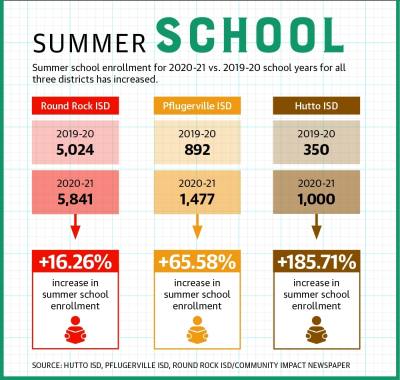“Please let my kids, let all Round Rock students, have a normal year,” Farris said. “My daughter will be a junior and has never gotten to experience an authentic year of high school.”
A parent of a Round Rock High School graduate—as well as a high school student and a middle school student—Farris said not only has her daughter been affected by the mandates of the COVID-19 pandemic, but her son was also forced to give up an extracurricular activity during the 2020-21 school year to make up an education gap caused by remote learning.
Farris is one of many parents whose children experienced a loss of knowledge, or learning loss, as schools throughout the country took action to address safety concerns around the pandemic and shift to remote learning.
Now, officials at Round Rock, Pflugerville and Hutto ISDs are working to address the learning losses that resulted from shifts to virtual learning or lessons that were not otherwise retained by students.
Whether through the addition of new positions or additional tutoring for skills identified as not having been mastered, districts are ramping up their efforts to close the learning gaps brought about by the pandemic.
Farris also pointed out a pervasive issue educators are now working to correct.
“I’m a stay-at-home mom with ample time and resources to help my child be right,” she told board members. “If my child is behind with all of the time and effort we put into helping him read, what about the kids that don’t have all that?”
Gauging learning loss
According to the Texas Education Agency, students in Texas on average experience a 2.5-month learning loss returning to school each fall. This means students typically forget 2.5 months worth of lessons taught by instructors each summer. According to the TEA, that amount of learning loss is normal.
Commonly referred to by educators as the “summer slide,” school districts account for it each year by reviewing content from the previous year early in the academic term.
However, experts say the normal gap in learning created by summer break was exacerbated by the abrupt departure many school districts made following spring break in 2020, when the COVID-19 virus became a national concern.
The TEA stated that the 5.7 months of learning loss resulting from COVID-19’s broad impact on the 2019-20 and 2020-21 school years is exceptional.
While the TEA collects learning loss metrics in a monthly format, it is not a data collection tactic that is common among local districts. At RRISD and HISD, student development is tracked individually.
“We don’t gather data exactly the way the state does,” said Robert Sormani, HISD assistant superintendent of instruction and innovation. “I do know our kids are further behind than they’ve been in my entire educational career.”
Sormani said regardless of whether a child attended school virtually or in person, many factors impacted lesson retention.
Another way of measuring learning loss, Sormani said, is to examine student results of the standardized exam known as the State of Texas Assessments of Academic Readiness, or STAAR.
Ryan Smith, RRISD executive director of teaching and learning, said that while STAAR scores may not be the best indicator of performance as a whole, the district does not have another viable metric accessible to the public yet.
He said the district will present information regarding learning loss and acceleration at future school board meetings.
“Our teachers are going to adapt and differentiate for each of their students as opposed to looking at some aggregate numbers,” Smith said. “I know we looked at STAAR results, obviously. But we’re also looking at the participation rate and starting to get a better view of what that large districtwide number really means, because we did have so many students that opted to not take the STAAR assessment.”
Locally, the largest decrease in the number of students who tested for STAAR exams across all exams administered in spring 2019 versus spring 2021 was in Round Rock ISD. In spring 2019, 2,508.96 students on average took each STAAR exam, which is weighted most heavily by third- through eighth-grade reading and math.
In spring 2021, 1,491 students took the STAAR for an average reduction of 1,017.52 students, or 40.57% decrease per exam.
Pflugerville ISD and Hutto ISD each saw less severe reductions in the number of students who took STAAR exams—losing an average of 40 students per exam in 2020-21.
School administrators point out STAAR exams were not administered during the 2019-20 school year due to the pandemic; therefore, test result data is analyzed from 2018-19 to 2020-21.
Figures comparing those two years’ results show each school district experienced increases in the proportion of students who did not meet grade level standards.
Among all three school districts, there was a 12% increase in 2020-21 in the number of students who did not meet grade-level standards.
In RRISD, there was an average increase of 9.97% for students who did not meet state grade-level standards.
PfISD saw a slightly higher increase of 14.15% year over year from 24.78% in 2019 to 38.94% of students not meeting standards in 2021. HISD fell in the middle with a 13.5% increase, from 24.37% to 37.87%.
Where learning loss occurred
The exams that experienced the largest increase in students who did not meet grade-level standards in PfISD and HISD were eighth-grade STAAR mathematics. Similarly, the largest increase in “did not meet standards” in RRISD was for third-grade STAAR Spanish mathematics, with the caveat provided that the exam was administered to less than 70 students during both years.
Some exams actually saw a reduction in the number of students who did not meet grade-level standards. In RRISD, there was a 38% reduction for fourth-grade STAAR Spanish Reading and a 4% reduction in the English I end-of-course exam as well as a 10% reduction in Fourth-grade Spanish reading in HISD.
Starting in the classroom
Educators identified a number of ways to address COVID-19-related learning loss and have been working to rectify the issue for the 2021-22 school year.
At RRISD, board members approved 87.9 full-time positions to combat learning loss and accelerate learning. RRISD underwrote funding for the additional staff through $4.3 million in federal grant money through the American Rescue Plan Act.
The new positions, which included additional middle and high school teachers, counselors and interventionists, were in the 2020-21 budget but went unfilled due to lower enrollment. Representatives from each RRISD campus provided feedback on what they needed to succeed in the coming year, Chief of Schools and Innovation Daniel Presley said at a July 15 board meeting.
“Some principals felt like they needed additional staff,” Presley said. “Because of certain situations, they needed smaller classes, and others, they were granted that. [We had] some other stuff like their class sizes were adequate, but they would rather have an instructional coach or other things they needed.”
Similarly, HISD will add 22 positions at its campuses for the coming school year to address learning loss. The bulk will be concentrated in elementary schools, with seven full-time teaching positions and seven teacher aide positions being placed at those campuses. Eight teacher aide positions are planned for secondary education.
Sormani said the added staff will allow for smaller class sizes and afford students extra attention to develop skills that need extra polishing. He said additional tutoring will occur alongside the day’s lesson, using grade standards tracked to skills they did not master the previous year but are necessary to complete that day’s lesson successfully.
“We’re actually putting in the tutoring during the day to work with the kids. ... So, rather than them missing the day’s lesson, they’ll get the day’s lesson,” Sormani said.
Smith said RRISD is taking a similar approach this fall, although overall lessons will be more customized to the needs of each student through the district’s learning management system, Schoology.
While both RRISD and HISD have already identified which positions they are adding and how they are going to use them, Pflugerville ISD is on a different timeline.
The district has begun the process of gathering information for additional positions for the 2021-22 school year, funded by the Elementary and Secondary School Emergency Relief III grant made available to states through the ARPA.
It is unclear how many positions might be added to the district’s plan for the fall semester, but PfISD Chief of Academics and Innovation Brandy Baker said the district is receiving and considering requests from campuses to determine where the positions are most needed.
Once students are back on campus, Baker said the district will conduct benchmark testing to assess where students are academically. When the degree of learning loss can be determined, student-level data will show what areas of learning need to be addressed by educators during the school year, she said.
Smith said he hopes the impact of the pandemic on the district’s younger students will be minimal.
“I hope that our youngest students, they look back on this and hear about it in stories and they kind of have vague memories [of a] weird 18-month period of time when all this was happening, but they don’t notice so much of a change,” Smith said.








